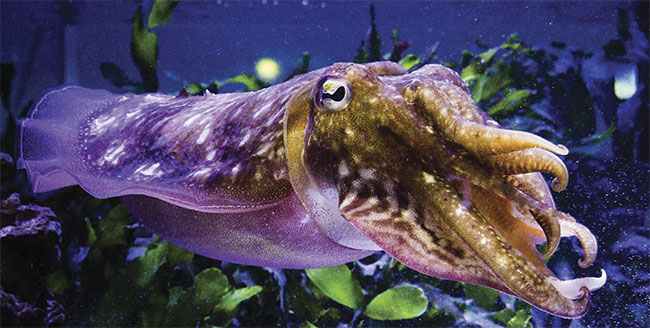Scientists have long believed that when cuttlefish camouflage in response to danger, they physiologically choose a color pattern from a limited number of pigmentation schemes to best match their surroundings. But a team of researchers from Asia and Europe has determined it to be a far more complicated process than that. Rather than selecting colors from a limited number of patterns, the common European cuttlefish, Sepia officinalis, mixes and matches colors until it finds the best style. The creatures are, in many ways, seaborne painters.
Researchers at the Okinawa Institute of Science and Technology (OIST) and the Max Planck Institute (MPI) for Brain Research in Germany learned, with the aid of high-resolution cameras, that pattern selection is an extensive process for cuttlefish. Neural signals precisely control the muscles surrounding millions of tiny skin pigment cells, called chromatophores, to reveal or hide color patterns to complement whatever background the fish respond to. And sometimes they even switch back and forth among color patterns, making them indecisive (and yet surprisingly engaged) judges of color.

The common cuttlefish, or Sepia officinalis. Courtesy of Stephan Junek/MPI Brain Research.
And the group further learned that blanching, or the lightening of the skin’s pigmentation in response to a direct threat, happened much more quickly than the aforementioned camouflaging, indicative of a more direct process of color change. Life or death clearly abbreviates the time to make a choice.
“Many earlier studies used qualitative or simple quantitative methods to categorize skin patterns into a few groups,” said Samuel Reiter, assistant professor in the computational neuroethology unit at OIST who helped supervise the study. “Going in, we thought we could use computer vision techniques to cluster a larger number of skin patterns after observing the complexity of the behavior by eye. We were surprised to find a rich continuum of different patterns, rather than a discreet set.”
In their study, the group explained that cuttlefish were filmed in a tank, where their vision was obstructed with a black frame except for a 400- × 400-mm area for viewing. The tank was lit with LED strip lights with diffusers, and background images were presented as prints on a fabric roll. Dozens of backgrounds were displayed, and to generate a direct threat, an experimenter’s hand was extended in the direction of the captive animal. Hundreds of thousands of images were collected with the aid of 17 Basler ace cameras arranged in a 2D array to record both high-resolution and low-resolution information, from individual chromatophores as well as behavioral patterns. The resulting data was directly analyzed with multiple computers and software.
“We used a pretrained network that had been shown to parameterize visual textures well,” Reiter said. “Treating both background images and camouflage patterns as visual textures and describing them using this technique was useful, as it let us quantify the ‘match’ of a camouflage pattern to a background image.”
Following their discovery, the next step in research could be to ascertain how the brain functions during this process. Reiter envisioned a variety of imaging methods and electrophysiology playing a role in the next level of experiments.
But all of the evidence they collected so far showed the scientists that camouflaging is not only a lengthier process than expected but is also based on the response of constant visual feedback. Like any good consumer, they adjust their choices based on a continuous flow of information. Good thing life above and below the water is so colorful.